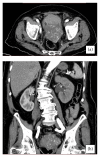Primary angiosarcoma of urinary bladder: 13th reported patient
- PMID: 25688314
- PMCID: PMC4321076
- DOI: 10.1155/2015/652870
Primary angiosarcoma of urinary bladder: 13th reported patient
Abstract
Angiosarcoma of the urinary bladder is an extremely rare and poorly characterized tumor. We are presenting the 13th reported patient who was an 89-year-old man initially presented with massive hematuria. His past medical history included external-beam radiation for prostate cancer 12 years ago. His PSA was 0.26 ng/dL. His CT-Urography demonstrated a highly vascular mass originating from the bladder base. The mass was partially resected, transurethrally. The pathology was consistent with primary angiosarcoma of the urinary bladder. Bone scan and CT-U showed metastasis to spine. The patient was treated with palliative radiotherapy for back pain due to metastasis, and he refused chemotherapy. The patient died 3 months after his initial diagnosis.
Figures


Similar articles
-
Angiosarcoma of the Urinary Bladder Following Radiotherapy: Report of a Case and Review of the Literature.Medicina (Kaunas). 2021 Apr 1;57(4):329. doi: 10.3390/medicina57040329. Medicina (Kaunas). 2021. PMID: 33915778 Free PMC article. Review.
-
More advantages in detecting bone and soft tissue metastases from prostate cancer using 18F-PSMA PET/CT.Hell J Nucl Med. 2019 Jan-Apr;22(1):6-9. doi: 10.1967/s002449910952. Epub 2019 Mar 7. Hell J Nucl Med. 2019. PMID: 30843003
-
Ct2 Bladder Cancer.Curr Urol Rep. 2016 Sep;17(9):66. doi: 10.1007/s11934-016-0624-0. Curr Urol Rep. 2016. PMID: 27457483
-
Angiosarcoma of the Bladder: Review of the Literature and Discussion About a Clinical Case.Urol Case Rep. 2017 Apr 27;13:97-100. doi: 10.1016/j.eucr.2016.12.007. eCollection 2017 Jul. Urol Case Rep. 2017. PMID: 28480169 Free PMC article.
-
Angiosarcoma of the bladder: a review.Urology. 1998 Nov;52(5):778-84. doi: 10.1016/s0090-4295(98)00286-6. Urology. 1998. PMID: 9801098 Review.
Cited by
-
Epithelioid Angiosarcoma of the Urinary Bladder After Brachytherapy for Prostatic Carcinoma: A Case Report and Literature Review.Cureus. 2025 Jan 14;17(1):e77414. doi: 10.7759/cureus.77414. eCollection 2025 Jan. Cureus. 2025. PMID: 39958141 Free PMC article.
-
A Primary Epithelioid Angiosarcoma Arising in a Bilharzial Urinary Bladder: A Reappraisal and Case Report.Asian Pac J Cancer Prev. 2023 Jan 1;24(1):87-92. doi: 10.31557/APJCP.2023.24.1.87. Asian Pac J Cancer Prev. 2023. PMID: 36708556 Free PMC article.
-
Bladder angiosarcoma: a systematic literature review and survival analysis.Proc (Bayl Univ Med Cent). 2025 Mar 14;38(3):305-312. doi: 10.1080/08998280.2025.2476319. eCollection 2025. Proc (Bayl Univ Med Cent). 2025. PMID: 40291080 Free PMC article. Review.
-
Primary bladder angiosarcoma synchronous with prostatic acinar adenocarcinoma in an 82-year-old male.Arch Clin Cases. 2021 Oct 27;7(3):52-56. doi: 10.22551/2020.28.0703.10173. eCollection 2020. Arch Clin Cases. 2021. PMID: 34754928 Free PMC article.
-
Primary Urinary Bladder Angiosarcoma with Osteoclast-Like Multinucleated Giant Cells: A Case Report and Literature Review.Am J Case Rep. 2016 Mar 7;17:143-9. doi: 10.12659/ajcr.896266. Am J Case Rep. 2016. PMID: 26947436 Free PMC article. Review.
References
LinkOut - more resources
Full Text Sources
Other Literature Sources
Research Materials
Miscellaneous

